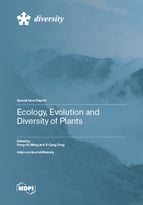Tracing the Evolution of Plant Diversity in Southwestern China
Round 1
Reviewer 1 Report
Dear Editor,
The manuscript is well adapted to the 'comment' format of the journal, conveying as its main concept the need to establish an adequate chronological framework that allows following the temporal sequence of the paleobotanical evolution and diversity in SW China with certainty. The presentation of ideas and their scientific basis is adequate and, at the same time, the text has great narrative flow.
The need to establish a robust chronological framework is of great importance, since the interpretation of paleobotanical results and the understanding of evolutionary and/or paleoecological processes depend directly on the temporal context. In addition, the interpretation of historical evolutionary processes is relevant at the global level.
I recommend that the manuscript be accepted for publication.
----
Minor revision
Line 71: Replace `Phytoplaeoaltimetric´ by `Phytopaleoaltimetric´
Author Response
Line 71: Replace `Phytoplaeoaltimetric´ by `Phytopaleoaltimetric´
Response: We have replaced `Phytoplaeoaltimetric´ by `Phytopaleoaltimetric´ .
Reviewer 2 Report
Reviewer opinion about “Tracing the Evolution of Plant Diversity in Southwestern
China” by Tao Su, Robert A. Spicer and Zhe-Kun Zhou
The commentary paper provides an excellent summary of one of the most important issues on Earth's biodiversity and its development, biodiversity hotspots, mainly in SW China. It is emphasized that the geological and climate changes in the Paleogene have led to a transformation of vegetation, which may have led to a long-term biodiversity hotspot in southwest China. So the geological development of the area, the development of the Southeast Asian monsoon, the uplift of the Himalayas and the Tibetan-Qinghai plateau together led to the geomorphological and climatic situation to which the paleoflora gradually adapted, resulting a biodiversity peak. I totally agree with the authors that future studies should be based on high resolution paleobiological analyses of Neogene and Paleogene sediments. However, geological and paleontological drilling and analysis targeting mineral resources and energy sources are not suitable for this! I suggest that studies in this area should be based on computed tomography (CT) analysis of undisturbed sedimentary core samples. Applying this method, we can detect those sedimentological characteristics that resulted due to sudden geological and/or climatic events (short-term events) which researchers may have skipped due to previous sampling techniques. Nevertheless, these short-term events cause rapid and vigorous fundamental changes in vegetation and provide a better understanding of the appearance and transformation of species. The references of the commentary paper is very regional and local, may be due to the topic.
It is particularly conspicuous that I did not find any reference to Professor Katherine Jane Willis, principal of St Edmund Hall at University of Oxford, or Professor Robert J. Whittacker at University of Oxford, who are excellent researchers in this subject. In order to attract more international researchers, it is necessary to go beyond regional reference publications and include the most prominent global biodiversity references in the commentary paper.
I found a typo on line 71.
References (for example)
Willis, K., & McElwain, J. (2014). The evolution of plants. Oxford University Press, Oxford, p. 185.
Willis, K.J., Bennett, K.D., Burrough, S.L., Macias-Fauria, M., & Tovar, C. (2013). Determining the response of African biota to climate change: using the past to model the future. Philosophical Transactions of the Royal Society B: Biological Sciences, 368(1625), 20120491.
Willis, K.J., Araújo, M.B., Bennett, K.D., Figueroa-Rangel, B., Froyd, C.A., & Myers, N. (2007). How can a knowledge of the past help to conserve the future? Biodiversity conservation and the relevance of long-term ecological studies. Philosophical Transactions of the Royal Society B: Biological Sciences, 362(1478), 175-187.
Willis, K.J., Gillson, L., & Knapp, S. (2007). Biodiversity hotspots through time: an introduction. Philosophical Transactions of the Royal Society B: Biological Sciences, 362(1478), 169-174.
Willis, K.J., & Whittaker, R.J. (2002). Species diversity - scale matters. Science, 295(5558), 1245-1248.
Willis, K.J., Bennett, K.D., Bhagwat, S.A., & Birks, H.J.B. (2010). 4°C and beyond: what did this mean for biodiversity in the past?. Systematics and Biodiversity, 8(1), 3-9.
Willis, K.J., Bailey, R.M., Bhagwat, S.A., & Birks, H.J.B. (2010). Biodiversity baselines, thresholds and resilience: testing predictions and assumptions using palaeoecological data. Trends in ecology & evolution, 25(10), 583-591.
Ladle, R.J. and Whittaker, R.J. (eds.) (2011). Conservation Biogeography. Wiley-Blackwell, Oxford. pp. 320. ISBN: 978-1-4443-3503-3
Whittaker, R. J., Willis, K. J., & Field, R. (2001). Scale and species richness: towards a general, hierarchical theory of species diversity. Journal of biogeography, 28(4), 453-470.
Bennett, K. D., & Provan, J. (2008). What do we mean by ‘refugia’?. Quaternary Science Reviews, 27(27-28), 2449-2455.
Comments for author File: ![]() Comments.pdf
Comments.pdf
Author Response
Point 1: I suggest that studies in this area should be based on computed tomography (CT) analysis of undisturbed sedimentary core samples. Applying this method, we can detect those sedimentological characteristics that resulted due to sudden geological and/or climatic events (short-term events) which researchers may have skipped due to previous sampling techniques. Nevertheless, these short-term events cause rapid and vigorous fundamental changes in vegetation and provide a better understanding of the appearance and transformation of species.
Response: Yes, we have added this method, please check lines 86-87 in the revision.
Point 2:
The references of the commentary paper is very regional and local, may be due to the topic.
It is particularly conspicuous that I did not find any reference to Professor Katherine Jane Willis, principal of St Edmund Hall at University of Oxford, or Professor Robert J. Whittacker at University of Oxford, who are excellent researchers in this subject. In order to attract more international researchers, it is necessary to go beyond regional reference publications and include the most prominent global biodiversity references in the commentary paper.
Response: This commentary paper focuses on region in Yunnan. However, to attract more international reserachers, we have added two references (Willis et al., 2007; Bennett and Provan, 2008) as suggested by the reviewer.
Point 3: I found a typo on line 71.
Response: We have replaced 'Phytoplaeoaltimetric' by 'Phytopaleoaltimetric '.






